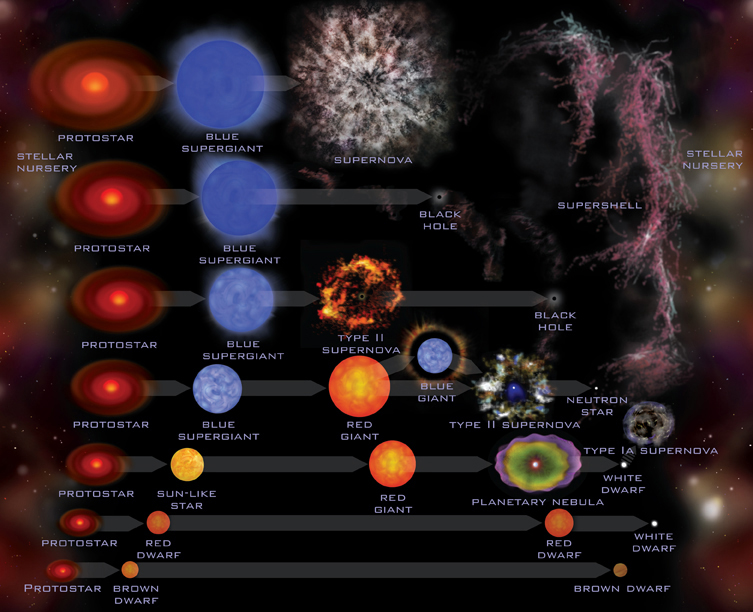It looks like you're using an Ad Blocker.
Please white-list or disable AboveTopSecret.com in your ad-blocking tool.
Thank you.
Some features of ATS will be disabled while you continue to use an ad-blocker.
share:
If the light just reached us, and the 'debris' travelled at 10% (or 1/10) the speed of light, the debris would take 10 times as long and thus 120 million years to reach us. So it seems we have around 108 million years to wait for the debris.
Beavers
reply to post by proob4
The light took 12 million years already and has just hit us.
If the debris travelled at 10% of the speed of light, the answer would be something along the lines of 10.8 million years.
I just don't know how fast it travels..
edit on 1/22/2014 by abecedarian because: (no reason given)
It will never reach us. Any massive particles will most likely never reach the escape velocity of its parent galaxy. It will continue to circle the
galaxy and some of it will go on to make new stars and planets.
reply to post by nitetrain
Making a mental note to ask my astronomy professor whether there is debris or not, and where gold comes from.
Making a mental note to ask my astronomy professor whether there is debris or not, and where gold comes from.
Beavers
reply to post by nofear39
12 million years have already passed.
So another 10.8 million years from now if 10% is correct...
More like 108 million years if it travels at 10% the speed of light and it took 12 million for the light to reach us,
Beavers
reply to post by boncho
I hadn't thought of that, I just assumed it would explode 360 degrees and at least something would come our way (eventually) but you make a good point.
I'm still interested in the estimated speed if you find anything!
It's irrelevant because that's not how it work. But in case you're wonder debris from a supernova would not travel at even .001% of the speed of light. And even that slows down further as it encounters the interstellar medium and other particles.
Here's a helpful graphic on stellar evolution. What a supernova leaves behind is a planetary nebula or in some cases, a stellar nursery. As you can see, death leads to new life.

edit on 28-1-2014 by JadeStar because: (no reason given)
edit on 28-1-2014 by JadeStar because: (no reason given)
InhaleExhale
Beavers
reply to post by nofear39
12 million years have already passed.
So another 10.8 million years from now if 10% is correct...
More like 108 million years if it travels at 10% the speed of light and it took 12 million for the light to reach us,
Math in this thread has been atrocious. Yours is correct (star for that) but the premise of the whole thread is wrong since this stuff will never reach the solar system in any significant way for a number of reasons which include interactions with the interstellar medium.
Even if it did somehow manage to escape such physical interactions.......
Such debris doesn't travel at 10% of the speed of light more like .001% of the speed of light or approx 670,000,000 kilometers per hour (approx 416,000,000 miles per hour). This is basic astronomy.
That would be 1,080,000 million years (1,080 Billion Years) or 1.08 TRILLION years from now...
The Sun will have long since died, it will go off the main sequence in about 4-5 billion years from now, entering red giant phase.
The universe itself will likely cease to exist by then with most theories having the universe ending in another 15-20 billion years.
edit on
28-1-2014 by JadeStar because: (no reason given)
new topics
-
Simple Thanksgiving
Food and Cooking: 3 hours ago -
Trump could make a peaceful American Revolution
US Political Madness: 6 hours ago -
Trump Presidential Transition Team will not use GSA or Government entities to come to DC
US Political Madness: 7 hours ago -
Mind Blowing Cave under someones land
Fragile Earth: 7 hours ago -
The Party of Peace - Trump Cabinet Picks Targeted with Death Threats
US Political Madness: 8 hours ago -
V.P. Kamala Harris releases a video and nobody understands why
US Political Madness: 11 hours ago
top topics
-
D.B. Cooper mystery may be solved
General Conspiracies: 16 hours ago, 21 flags -
V.P. Kamala Harris releases a video and nobody understands why
US Political Madness: 11 hours ago, 16 flags -
The Party of Peace - Trump Cabinet Picks Targeted with Death Threats
US Political Madness: 8 hours ago, 14 flags -
Trump Presidential Transition Team will not use GSA or Government entities to come to DC
US Political Madness: 7 hours ago, 13 flags -
Trump could make a peaceful American Revolution
US Political Madness: 6 hours ago, 13 flags -
Mind Blowing Cave under someones land
Fragile Earth: 7 hours ago, 12 flags -
Simple Thanksgiving
Food and Cooking: 3 hours ago, 5 flags
